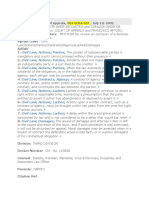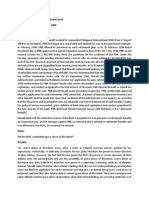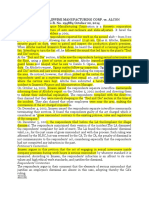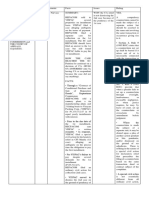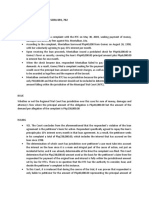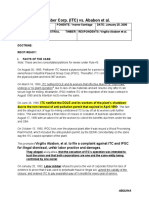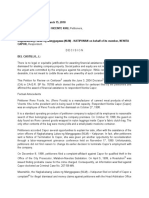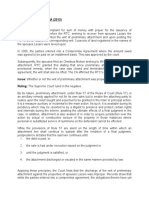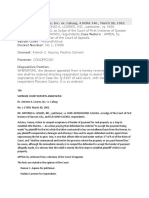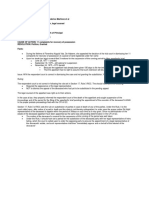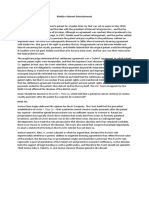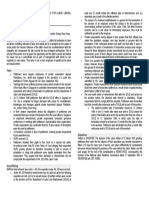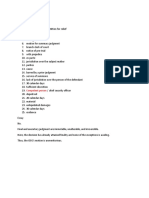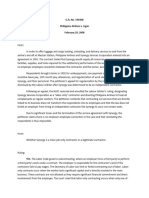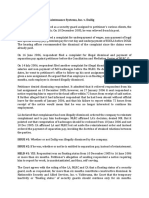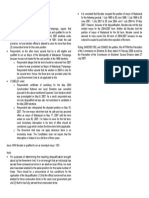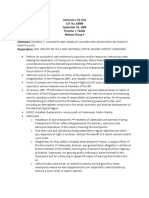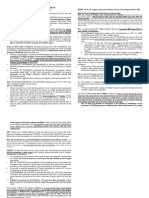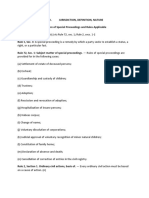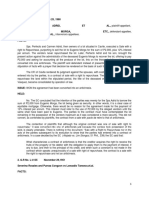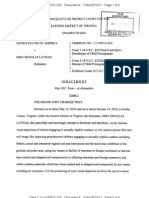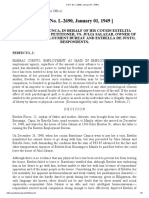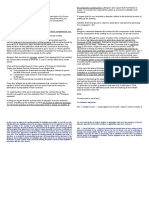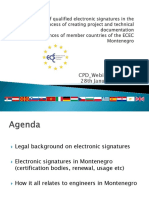Emeritus Security V Dailig
Emeritus Security V Dailig
Uploaded by
Chelle BelenzoCopyright:
Available Formats
Emeritus Security V Dailig
Emeritus Security V Dailig
Uploaded by
Chelle BelenzoOriginal Description:
Original Title
Copyright
Available Formats
Share this document
Did you find this document useful?
Is this content inappropriate?
Copyright:
Available Formats
Emeritus Security V Dailig
Emeritus Security V Dailig
Uploaded by
Chelle BelenzoCopyright:
Available Formats
Emeritus Security v Dailig | G.R. No. 204761 | April 2, 2014 | J.
Carpio
Petitioner: EMERITUS SECURITY AND MAINTENANCE SYSTEMS, INC.,
Respondent: JANRIE C. DAILIG
FACTS:
August 2000 Petitioner hired respondent as one of its security guards.
During his employment, respondent was assigned to petitioner's various clients, the last of which was
Panasonic in Calamba, Laguna starting 16 December 2004.
December 10, 2005 respondent was relieved from his post.
January 27, 2006, respondent filed a complaint for underpayment of wages, non-payment of legal and
special holiday pay, premium pay for rest day and underpayment of ECOLA before the Department of Labor
and Employment, National Capital Region
o Hearing officer recommended the dismissal of the complaint since the claims were already paid.
June 16, 2006 respondent filed a complaint for illegal dismissal and payment of separation pay against
petitioner before the Conciliation and Mediation Center of the NLRC.
July 14, 2006 respondent filed another complaint for illegal dismissal, underpayment of salaries and non-
payment of full backwages before the NLRC.
Respondent’s claims
o claimed that on various dates in December 2005 and from January to May 2006, he went to
petitioner’s office to follow-up his next assignment.
o After more than six months since his last assignment, still respondent was not given a new
assignment.
o argued that if an employee is on floating status for more than six months, such employee is
deemed illegally dismissed.
Petitioner’s arguments
o denied dismissing respondent.
o admitted that it relieved respondent from his last assignment on 10 December 2005; however,
petitioner required respondent to report to the head office within 48 hours from receipt of the order
of relief. Respondent allegedly failed to comply.
o Petitioner claimed that on 27 January 2006 it sent respondent a notice to his last known address
requiring him to report to the head office within 72 hours from receipt of the said notice.
o It had informed respondent that he had been absent without official leave for the month of January
2006, and that his failure to report within 72 hours from receipt of the notice would mean that he
was no longer interested to continue his employment.
o Claimed that there was no showing that respondent was prevented from returning to his work and
that it had consistently manifested its willingness to reinstate him to his former position.
o Fact that there was no termination letter sent to respondent purportedly proved that respondent
was not dismissed.
LA Decision Respondent was illegally dismissed. Ordered reinstatement and payment of backwages
from the time his compensation was withheld by reason of his illegal dismissal until actual reinstatement.
NLRC dismissed appeal for lack of merit. Motion for reconsideration was denied. Computation of
backwages from June 10, 2006 not December 10 2005.
CA Affirmed LA finding and NLRC Respondent was illegally dismissed.
Issues
W/N respondent was illegally dismissed
If he was illegally dismissed, whether respondent is entitled to separation pay, instead of reinstatement.
SC Ruling:
The Court affirms the finding of illegal dismissal of the Labor Arbiter, NLRC, and Court of Appeals.
However, the Court sets aside the Court of Appeals’ award of separation pay in favor of respondent, and
reinstates the Labor Arbiter’s reinstatement order.
FIRST ISSUE: On whether respondent was illegally dismissed? YES
Petitioner admits relieving respondent from his post as security guard on 10 December 2005.
There is also no dispute that respondent remained on floating status at the time he filed his complaint for
illegal dismissal on 16 June 2006.
Respondent was on floating status from 10 December 2005 to 16 June 2006 or more than six months.
Petitioner’s allegation of sending respondent a notice sometime in January 2006, requiring him to report for
work, is unsubstantiated, and thus, self-serving.
A floating status of a security guard, such as respondent, for more than six months constitutes constructive
dismissal.
Nationwide Security and Allied Services, Inc. v. Valderama x x x the temporary inactivity or "floating
status" of security guards should continue only for six months. Otherwise, the security agency concerned
could be liable for constructive dismissal. The failure of petitioner to give respondent a work assignment
beyond the reasonable six-month period makes it liable for constructive dismissal. x x x. 9
Labor Arbiter, NLRC, and Court of Appeals unanimously found that respondent was illegally dismissed by
petitioner. Factual findings of quasi-judicial bodies like the NLRC, if supported by substantial evidence, are
accorded respect and even finality by this Court, more so when they coincide with those of the Labor Arbiter.
SECOND ISSUE: On whether respondent is entitled to separation pay
Article 279 of the Labor Code of the Philippines mandates the reinstatement of an illegally dismissed
employee, to wit: Security of Tenure. - x x x An employee who is unjustly dismissed from work shall be
entitled to reinstatement without loss of seniority rights and other privileges and to his full back wages,
inclusive of allowances, and to his other benefits or their monetary equivalent computed from the time his
compensation was withheld from him up to the time of his actual reinstatement.
Reinstatement is the general rule, while the award of separation pay is the exception.
Circumstances warranting the grant of separation pay, in lieu of reinstatement (Globe-Mackay Cable and
Radio Corporation v. National Labor Relations Commission)
o reinstatement can no longer be effected in view of the long passage of time (22 years of litigation)
or because of the realities of the situation; or that
o Reinstatement would be ‘inimical to the employer’s interest;’
o Reinstatement may no longer be feasible;
o It will not serve the best interests of the parties involved
o The company would be prejudiced by the workers’ continued employment;
o it will not serve any prudent purpose as when supervening facts have transpired which make
execution on that score unjust or inequitable
o An increasing extent, due to the resultant atmosphere of ‘antipathy and antagonism’ or ‘strained
relations’ or ‘irretrievable estrangement’ between the employer and the employee.
In this case, petitioner claims that it complied with the reinstatement order of the Labor Arbiter.1âwphi1
o 23 January 2008 petitioner sent respondent a notice informing him of the Labor Arbiter’s
decision to reinstate him.
o February 2008 respondent was assigned by petitioner to Canlubang Sugar Estate, Inc. in
Canlubang, Laguna, and to various posts thereafter.
o At the time of the filing of the petition, respondent was assigned by petitioner to MD Distripark
Manila, Inc. in Biñan, Laguna.
o Respondent admits receiving a reinstatement notice from petitioner.
o Thereafter, respondent was assigned to one of petitioner's clients.
o Respondent points out that he was not reinstated by petitioner Emeritus Security and Maintenance
Systems, Inc. but was employed by another company, Emme Security and Maintenance Systems,
Inc. (Emme). Thus, according to respondent, he was not reinstated at all.
o Petitioner counters that Emeritus and Emme are sister companies with the same Board of Directors
and officers, arguing that Emeritus and Emme are in effect one and the same corporation.
o Considering petitioner's undisputed claim that Emeritus and Emme are one and the same, there is
no basis in respondent's allegation that he was not reinstated to his previous employment.
o Besides, respondent assails the corporate personalities of Emeritus and Emme only in his
Comment filed before this Court. Further, respondent did not appeal the Labor Arbiter's
reinstatement order.
Contrary to the Court of Appeals' ruling, there is nothing in the records showing any strained relations
between the parties to warrant the award of separation pay. There is neither allegation nor proof that such
animosity existed between petitioner and respondent. In fact, petitioner complied with the Labor Arbiter's
reinstatement order.
Considering that (1) petitioner reinstated respondent in compliance with the Labor Arbiter's decision, and (2)
there is no ground, particularly strained relations between the parties, to justify the grant of separation pay,
the Court of Appeals erred in ordering the payment thereof, in lieu of reinstatement.
JUDGMENT: WHEREFORE, the Court DENIES the petition and REINSTATES the 5 December 2007 Decision of the
Labor Arbiter. However, the backwages should be computed from 10 June 2006 when respondent was illegally
dismissed up to the time he was reinstated in February 2008.
You might also like
- Magallon Vs Montejo DigestDocument2 pagesMagallon Vs Montejo DigestCarlota Nicolas Villaroman67% (3)
- Aranda Vs CADocument3 pagesAranda Vs CAdayneblazeNo ratings yet
- POLITICAL - Security and Seriff Division of SBVCRUZ - UYDocument1 pagePOLITICAL - Security and Seriff Division of SBVCRUZ - UYMikMik UyNo ratings yet
- Dreamwork V. Janiola: Prejudicial QuestionsDocument40 pagesDreamwork V. Janiola: Prejudicial QuestionsEryl YuNo ratings yet
- Juerez v. Court of Appeals, G.R. No. 93474, October 7, 1992Document1 pageJuerez v. Court of Appeals, G.R. No. 93474, October 7, 1992Eli SNo ratings yet
- Pascual Sr. V Caniogan CreditDocument2 pagesPascual Sr. V Caniogan CreditRaven Claire MalacaNo ratings yet
- de Castro vs. CA 384 Scra 607Document13 pagesde Castro vs. CA 384 Scra 607albemartNo ratings yet
- Magis Young Achievers' Learning Center v. Manalo CASE DIGESTDocument3 pagesMagis Young Achievers' Learning Center v. Manalo CASE DIGESTLBitzNo ratings yet
- Asayas v. Sea Power Shipping Enterprises, Inc., G.R. No. 201792, January 24, 2018, 852 SCRA 568Document1 pageAsayas v. Sea Power Shipping Enterprises, Inc., G.R. No. 201792, January 24, 2018, 852 SCRA 568Jacob CanelaNo ratings yet
- Maralit vs. Philippine National BankDocument3 pagesMaralit vs. Philippine National BankJunmer OrtizNo ratings yet
- Citizen Surety CaseDocument2 pagesCitizen Surety CaseKent UgaldeNo ratings yet
- Sps. Bergonia vs. CADocument3 pagesSps. Bergonia vs. CANympa VillanuevaNo ratings yet
- SECTION 74 Corporation Code Gonzales Vs PNB FactsDocument2 pagesSECTION 74 Corporation Code Gonzales Vs PNB Factshmn_scribdNo ratings yet
- PEOPLE Vs AlmendralDocument2 pagesPEOPLE Vs AlmendralpapaburgundyNo ratings yet
- Central Surety v. CN HodgesDocument12 pagesCentral Surety v. CN Hodgeskrys_elleNo ratings yet
- Manila Memorial v. LluzDocument2 pagesManila Memorial v. LluzFrancisco Ashley AcedilloNo ratings yet
- Imasen Philippine Manufacturing Corp. vs. Alcon G.R. No. 194884 October 22, 2014Document47 pagesImasen Philippine Manufacturing Corp. vs. Alcon G.R. No. 194884 October 22, 2014Chino CubiasNo ratings yet
- Manatad V PT - TDocument3 pagesManatad V PT - TDAblue ReyNo ratings yet
- Mayor v. IACDocument3 pagesMayor v. IACNorberto Sarigumba IIINo ratings yet
- Case DigestDocument62 pagesCase DigestMylesNo ratings yet
- Cardenas Vs Sps. AguilarDocument2 pagesCardenas Vs Sps. AguilarFrances SamsonNo ratings yet
- 427 LANDERIO Solid Homes Inc., V PayawalDocument1 page427 LANDERIO Solid Homes Inc., V PayawalCarissa CruzNo ratings yet
- Criminal ProcedureDocument55 pagesCriminal ProcedureCJ Ivanne DichosoNo ratings yet
- G.R. No. 65377 - Molave Motor Sales, Inc. v. LaronDocument4 pagesG.R. No. 65377 - Molave Motor Sales, Inc. v. LaronElla CanuelNo ratings yet
- Declaratory Relief - My PartDocument9 pagesDeclaratory Relief - My PartCristian RamirezNo ratings yet
- CASE No. 51 Agbada vs. Inter-Urban DevelopersDocument2 pagesCASE No. 51 Agbada vs. Inter-Urban DevelopersAl Jay Mejos100% (1)
- Gomez vs. MontalbanDocument2 pagesGomez vs. MontalbanR.E.D. DocenaNo ratings yet
- #19 Industrial Timber Corp. (ITC) vs. Ababon Et AlDocument3 pages#19 Industrial Timber Corp. (ITC) vs. Ababon Et AlKathrine Marie AbquinaNo ratings yet
- Cebu Royal PlantDocument1 pageCebu Royal Plantaags_06No ratings yet
- Bilflex Phil. Inc. Labor Union Et Al. V. Filflex Industrial and Manufacturing Corporation and Bilflex (Phils.), Inc. 511 SCRA 247 (2006), THIRD DIVISION (Carpio Morales, J.)Document1 pageBilflex Phil. Inc. Labor Union Et Al. V. Filflex Industrial and Manufacturing Corporation and Bilflex (Phils.), Inc. 511 SCRA 247 (2006), THIRD DIVISION (Carpio Morales, J.)piptipaybNo ratings yet
- Cabaobas V Pepsi-ColaDocument4 pagesCabaobas V Pepsi-ColachiiwaaaaaaaNo ratings yet
- Case No.21: Hambre J. Mohammad, Petitioner, V - Grace Belgado-SaquetonDocument1 pageCase No.21: Hambre J. Mohammad, Petitioner, V - Grace Belgado-SaquetonAlmiraNo ratings yet
- Abbot Vs Alcaraz 723 SCRA 25Document6 pagesAbbot Vs Alcaraz 723 SCRA 25PreciousNo ratings yet
- Octaviano V NLRCDocument5 pagesOctaviano V NLRCAleine Leilanie OroNo ratings yet
- N Acosta v. COMELEC DigestDocument2 pagesN Acosta v. COMELEC DigestNic OngNo ratings yet
- Negros Oriental Planters Association vs. Hon. Presiding Judge of NegrosDocument6 pagesNegros Oriental Planters Association vs. Hon. Presiding Judge of NegrosAnakataNo ratings yet
- Atlas Farm, Inc. v. NLRCDocument2 pagesAtlas Farm, Inc. v. NLRCAnonymous 5MiN6I78I0No ratings yet
- G.R. No. 164016 March 15, 2010 Reno Foods, Inc., And/Or Vicente KhuDocument19 pagesG.R. No. 164016 March 15, 2010 Reno Foods, Inc., And/Or Vicente KhunayhrbNo ratings yet
- Lim Vs Lazaro, 700 SCRA (2013)Document2 pagesLim Vs Lazaro, 700 SCRA (2013)MACNo ratings yet
- Power Commercial and Industrial Corporation Vs Ca - GR 119745 - June 20, 1997Document4 pagesPower Commercial and Industrial Corporation Vs Ca - GR 119745 - June 20, 1997BerniceAnneAseñas-Elmaco100% (1)
- Dr. Antonio Lizares vs. Caluag 14 Scra 746Document4 pagesDr. Antonio Lizares vs. Caluag 14 Scra 746albemartNo ratings yet
- 3 Enriquez - Security - Services - Inc. - v. - CabotajeDocument4 pages3 Enriquez - Security - Services - Inc. - v. - CabotajeMary Licel RegalaNo ratings yet
- Heirs of Simeon Borlado v. CADocument1 pageHeirs of Simeon Borlado v. CAEmma Ruby Aguilar-ApradoNo ratings yet
- REPUBLIC OF THE PHILIPPINES, represented by the Regional Executive Director of the Department of Environment and Natural Resources, Regional Office No. 3, petitioner, vs. ROMAN CATHOLIC ARCHBISHOP OF MANILA (RCAM), respondent. G.R. No. 192994. November 12, 2012.* SAMAHANG KABUHAYAN NG SAN LORENZO KKK, INC., represented by its Vice President Zenaida Turla, petitioner, vs. ROMAN CATHOLIC ARCHBISHOP OF MANILA, respondent. SAME SAMEDocument1 pageREPUBLIC OF THE PHILIPPINES, represented by the Regional Executive Director of the Department of Environment and Natural Resources, Regional Office No. 3, petitioner, vs. ROMAN CATHOLIC ARCHBISHOP OF MANILA (RCAM), respondent. G.R. No. 192994. November 12, 2012.* SAMAHANG KABUHAYAN NG SAN LORENZO KKK, INC., represented by its Vice President Zenaida Turla, petitioner, vs. ROMAN CATHOLIC ARCHBISHOP OF MANILA, respondent. SAME SAMEmonchievaleraNo ratings yet
- Heirs of Vda de Haberer vs. CADocument1 pageHeirs of Vda de Haberer vs. CAGillian Caye Geniza BrionesNo ratings yet
- GR NO. 211751 - Andes, CarmelaDocument4 pagesGR NO. 211751 - Andes, CarmelaCarmela Luchavez AndesNo ratings yet
- 01 Gabriel vs. Sec of LaborDocument2 pages01 Gabriel vs. Sec of LaborcagrnsNo ratings yet
- 5 Bautista vs. FerrerDocument2 pages5 Bautista vs. FerrermaggiNo ratings yet
- Kimble V Marvel EntertainmentDocument1 pageKimble V Marvel EntertainmentpyriadNo ratings yet
- 06 Fuentes V NLRCDocument1 page06 Fuentes V NLRCPaolo Miguel ArqueroNo ratings yet
- Pabon, Et Al., vs. NLRC and Senior Marketing Corp., G.R. No. 120457 (Sep. 24, 1998)Document1 pagePabon, Et Al., vs. NLRC and Senior Marketing Corp., G.R. No. 120457 (Sep. 24, 1998)Jolynne Anne GaticaNo ratings yet
- LC DigestDocument34 pagesLC DigestJuvylynPiojoNo ratings yet
- Sample Labor Law Bar QuestionsDocument8 pagesSample Labor Law Bar QuestionsCarol JacintoNo ratings yet
- Codal Rehash No 2Document1 pageCodal Rehash No 2Ralph CortezNo ratings yet
- Philippine Airlines vs. LiganDocument2 pagesPhilippine Airlines vs. LiganRed CollinsNo ratings yet
- G.R. No. 103119 October 21, 1992 SULPICIO INTOD, Petitioner, Honorable Court of Appeals and People of The PHILIPPINES, RespondentsDocument99 pagesG.R. No. 103119 October 21, 1992 SULPICIO INTOD, Petitioner, Honorable Court of Appeals and People of The PHILIPPINES, RespondentsSai RosalesNo ratings yet
- Flordeliza Maria Reyes-Rayel vs. Philippine Luen Thai Holdings, Et Al. G.R. No. 174893 July 11, 2012 DoctrineDocument2 pagesFlordeliza Maria Reyes-Rayel vs. Philippine Luen Thai Holdings, Et Al. G.R. No. 174893 July 11, 2012 DoctrineKhristienne BernabeNo ratings yet
- Ethics CasesDocument6 pagesEthics CasesdianedeeNo ratings yet
- Remedial Law March 03, 2022Document2 pagesRemedial Law March 03, 2022MarcJunardJoverNo ratings yet
- Emeritus Security & Maintenance Systems Inc., vs. DailigDocument2 pagesEmeritus Security & Maintenance Systems Inc., vs. DailigNej AdunayNo ratings yet
- Emeritus Security and Maintenance Systems, Inc. v. Dailig - DigestDocument2 pagesEmeritus Security and Maintenance Systems, Inc. v. Dailig - DigestRoxanne PeñaNo ratings yet
- 01 Laceda Sr. v. LimenaDocument1 page01 Laceda Sr. v. LimenaChelle BelenzoNo ratings yet
- 03 Dizon v. COMELECDocument1 page03 Dizon v. COMELECChelle BelenzoNo ratings yet
- Rivera Iii V Comelec (1991) : Term Limits - Sandoval-Gutierrez, J. - G.R. No. 167591, G.R. No. 170577Document2 pagesRivera Iii V Comelec (1991) : Term Limits - Sandoval-Gutierrez, J. - G.R. No. 167591, G.R. No. 170577Chelle BelenzoNo ratings yet
- 09 Albania v. TalladoDocument2 pages09 Albania v. TalladoChelle BelenzoNo ratings yet
- Abundo v. COMELEC - (VILLANGCA, Rogerson)Document4 pagesAbundo v. COMELEC - (VILLANGCA, Rogerson)Chelle BelenzoNo ratings yet
- 020 Govt of The PH V El HogarDocument6 pages020 Govt of The PH V El HogarChelle BelenzoNo ratings yet
- 05 CIR V Commonwealth Management and Services CorporationDocument2 pages05 CIR V Commonwealth Management and Services CorporationChelle BelenzoNo ratings yet
- Group 3 Negotiable Instruments ReportDocument16 pagesGroup 3 Negotiable Instruments ReportChelle BelenzoNo ratings yet
- People v. VillafloresDocument1 pagePeople v. VillafloresChelle BelenzoNo ratings yet
- (Digest) Abbott Labs V AlcarazDocument4 pages(Digest) Abbott Labs V AlcarazChelle BelenzoNo ratings yet
- Valmonte V de VillaDocument4 pagesValmonte V de VillaChelle BelenzoNo ratings yet
- Sumilang Vs RamagosaDocument2 pagesSumilang Vs RamagosaChelle BelenzoNo ratings yet
- 01 CIR V BF GoodrichDocument2 pages01 CIR V BF GoodrichChelle BelenzoNo ratings yet
- ARIAS V SANDIGANBAYANDocument2 pagesARIAS V SANDIGANBAYANChelle Belenzo83% (6)
- Jader-Manalo V CamaisaDocument2 pagesJader-Manalo V CamaisaChelle BelenzoNo ratings yet
- Fortaleza V LapitanDocument3 pagesFortaleza V LapitanChelle Belenzo100% (1)
- VETERANS FEDERATION OF THE PHIL V MontenejoDocument4 pagesVETERANS FEDERATION OF THE PHIL V MontenejoChelle Belenzo100% (1)
- Aristotle Valenzuela V ValenzuelaDocument3 pagesAristotle Valenzuela V ValenzuelaChelle Belenzo100% (1)
- Spec Pro Midterm NotesDocument4 pagesSpec Pro Midterm NotesChelle BelenzoNo ratings yet
- Michael Torrey Associates, LLC: USA WashingtonDocument3 pagesMichael Torrey Associates, LLC: USA WashingtonTorrentFreak_No ratings yet
- Cases For AntichresisDocument4 pagesCases For AntichresisJec Luceriaga BiraquitNo ratings yet
- Mike Latham IndictmentDocument4 pagesMike Latham IndictmentEmily BabayNo ratings yet
- Study Guide:: Reformation of InstrumentsDocument6 pagesStudy Guide:: Reformation of InstrumentsKelsey De GuzmanNo ratings yet
- Caunca v. SalazarDocument3 pagesCaunca v. SalazarCases M7No ratings yet
- People v. Lauga G.R. No. 186228 March 15, 2010Document3 pagesPeople v. Lauga G.R. No. 186228 March 15, 2010Emrico CabahugNo ratings yet
- Art. 35 George Culhi HambonDocument3 pagesArt. 35 George Culhi HambonPolistico KresNo ratings yet
- Bengson Vs Chan 1977Document2 pagesBengson Vs Chan 1977lovekimsohyun89100% (1)
- Bishop Amari Vs Villaflor GR 224521 Feb 17, 2020Document37 pagesBishop Amari Vs Villaflor GR 224521 Feb 17, 2020KM HanNo ratings yet
- THE STATE v. KWAKU NKYIDocument4 pagesTHE STATE v. KWAKU NKYISolomon BoatengNo ratings yet
- Criminology N.v.paranjapeDocument20 pagesCriminology N.v.paranjapeShivakshi Arora50% (2)
- Marriage ContractDocument7 pagesMarriage ContractGlenn C. Rimas0% (2)
- Waiver RT CNLDocument1 pageWaiver RT CNLMark ReinhardtNo ratings yet
- Bibliography: Commemoration. Chicago: SalsedoDocument9 pagesBibliography: Commemoration. Chicago: Salsedoapi-119394251No ratings yet
- United States v. Victor Orlando Nunez, 888 F.2d 1387, 4th Cir. (1989)Document2 pagesUnited States v. Victor Orlando Nunez, 888 F.2d 1387, 4th Cir. (1989)Scribd Government DocsNo ratings yet
- Special Power of Attorney Tits Peht - VernonDocument4 pagesSpecial Power of Attorney Tits Peht - VernonJairus RubioNo ratings yet
- Double Tax Avoidance AgreementDocument13 pagesDouble Tax Avoidance AgreementRavi SinghNo ratings yet
- BKG 18199245 2023 03 29 09 51 28 514Document1 pageBKG 18199245 2023 03 29 09 51 28 514AshpreetNo ratings yet
- Law Enforcement Organization and Administration Inter Agency ApproachDocument40 pagesLaw Enforcement Organization and Administration Inter Agency ApproachWind RocksNo ratings yet
- San Miguel Foods Inc V San Miguel Corporation Supervisors and Exempt UnionDocument3 pagesSan Miguel Foods Inc V San Miguel Corporation Supervisors and Exempt UniongabbyborNo ratings yet
- The Land Acquisition Act, 1894Document85 pagesThe Land Acquisition Act, 1894goutham raj konda jangamNo ratings yet
- III B People Vs Pugay DDocument2 pagesIII B People Vs Pugay DMargo GreenNo ratings yet
- 04 Montenegro Electonic SignaturesDocument13 pages04 Montenegro Electonic SignaturesrudnikaleksandarNo ratings yet
- Brown County DA Statement On GOTV EffortDocument2 pagesBrown County DA Statement On GOTV EffortJonathan KrauseNo ratings yet
- Jaubert Posadas SorianoDocument1 pageJaubert Posadas SorianoBert SorianoNo ratings yet
- People v. Castro, G.R. No. 172874Document14 pagesPeople v. Castro, G.R. No. 172874Abbie KwanNo ratings yet
- People v. AgbayaniDocument2 pagesPeople v. AgbayaniJames Ibrahim AlihNo ratings yet
- Recruitment Policy & ProceduresDocument6 pagesRecruitment Policy & Proceduresbear7No ratings yet
- U.S. History Unit 4 Civil War WebquestDocument4 pagesU.S. History Unit 4 Civil War WebquestFrancisco CurieNo ratings yet






